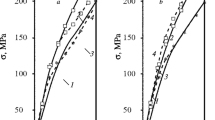Conclusions
A method for predicting by calculation the relaxation contributions to high-speed stretching diagrams from the characteristics of the measured relaxation process has been developed.
It has been found that even a slight manifestation of relaxation processes on transition to high-speed stretching leads to considerable changes in deformation stiffness characteristics.
Similar content being viewed by others
Literature cited
A. M. Stalevich, V. G. Tiranov, and G. Ya. Slutsker, Khim. Volokna, No. 4, 52–56 (1978).
A. M. Stalevich and L. E. Root, Khim. Volokna, No. 5, 36–37 (1980).
A. M. Stalevich et al., Khim. Volokna, No. 6, 36 (1982).
A. M. Stalevich, V. G. Tiranov, and G. N. Slutsker, Khim. Volokna, No. 1, 31–33 (1981).
A. M. Stalevich, Khim. Volokna, No. 6, 37 (1982).
A. M. Stalevich, V. A. Korovin, and V. F. Brusko, Izv. Vyssh. Uchebn. Zaved., Ser. Tekhnol. Tekst. Promst., No. 5, 17–21 (1981).
Additional information
Translated from Khimicheskie Volokna, No. 1, pp. 35–36, January–February, 1983.
Rights and permissions
About this article
Cite this article
Stalevich, A.M., Stalevich, Z.F., Sudarev, K.V. et al. High-speed stretching diagrams of synthetic fibres. Fibre Chem 15, 45–48 (1983). https://doi.org/10.1007/BF00545509
Received:
Issue Date:
DOI: https://doi.org/10.1007/BF00545509




